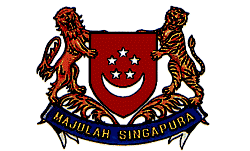
The Origin
Also known as the National Coat of Arms, the State Crest serves as a symbol of Singapore’s status as a self-governing and independent state.
Like the National Flag, the State Crest was conceived by a committee led by then Deputy Prime Minister Dr Toh Chin Chye. The five stars and crescent moon in the centre were Dr Toh's idea, as were the lion and tiger that stand on each side. Explaining his thinking then, Dr Toh said in an oral history interview with the National Archives of Singapore:
"Now in the case of the State Crest, again we got the five stars and the new moon. The ideas were mine. A lion next to a tiger. Tiger, of course, is a more local animal than the lion. What we did not have of course was a crown. You’d find that with the British national crest they have a crown, because they have a history of monarchy. We were a republic, no crown. So it looks empty. That, from the artistic point of view, something is missing. But what can we replace? Well, the old City Council had the Raffles Crest, I think it was a castle or something like that. And a lion. It did merge with our own ideas of self-governing Singapore."
Dr Toh Chin Chye, 1989.
Together with the National Flag and the National Anthem, the State Crest was passed by the Legislative Assembly on 18 November 1959 and unveiled during the installation of Encik Yusof bin Ishak as the Yang di-Pertuan Negara on 3 December 1959.
About Mr Joseph Teo
The late Mr Joseph Teo (1934-1989) was a 25-year-old newly-wed when Dr Toh Chin Chye sought his skills as an artist to produce the designs for the National Flag and the State Crest in 1959.
A largely self-taught artist, Mr Teo was an artist at the Ministry of Culture, which he joined in 1957, after working for five years as a draughtsman for a private company.
Until his retirement in 1984, Mr Teo served as the Chief Artist at the Ministry of Culture and later the Ministry of Communications and Information, where he played a key role in designing artwork for national campaigns and mascots such as the Courtesy Lion and Teamy Bee. He also designed the early medals for events such as the Southeast Asia (SEA) Games and prepared handwritten citations for the recipients of national awards and other honours.
Mr Teo’s work in creating the two national symbols was recognised in 1963 when he received the Public Administration Medal (Bronze).
Later, in 1968, he was awarded the Public Administration Medal (Silver).
Meaning
The State Crest of Singapore is formed by a shield emblazoned with a white crescent moon and five white stars against a red background.
Red is used to symbolise universal brotherhood and the equality of man, while white signifies pervading and everlasting purity and virtue. The five stars represent the national ideals of democracy, peace, progress, justice and equality. This motif is also found on the National Flag.
Supporting the shield are a lion on the left and a tiger on the right. A banner below the shield is inscribed with the Republic of Singapore's motto, 'Majulah Singapura' (meaning 'Onward Singapore' in Malay). The lion embodies Singapore itself while the tiger represents Singapore's historical ties with Malaysia.
Guidelines on the Use of the State Crest
The State Crest, also known as the National Coat of Arms, is governed by the National Symbols Act 2022 and Regulations, which came into effect on 1 August 2023, and is generally reserved for official use.
- Private use of State Crest for advertisement or commercial purposes is prohibited by law. Approval must be sought for any other use of the State Crest except for the purposes of reporting news.
- The State Crest should be treated with respect and displayed in a dignified manner.
Frequently Asked Questions
Display of the State Crest
- I would like to display the State Crest within my office premises. Can I do so?
No. Only Government Ministries may display the State Crest within their premises.
Using the State Crest
- Who may use the State Crest?
The State Crest is reserved for official use. Private use of the State Crest is prohibited by law. Approval must be sought for any other use of the State Crest except for the purpose of reporting news.
- I am from an advertising/design agency and I would like to use the State Crest as part of my graphic design on print advertisements, publicity materials, etc. Can I do so?
No. The State Crest cannot be used as a means, or for the purposes of any advertisement.
- I would like to use the State Crest as part of my product design which will be sold commercially. Can I do so?
No. The use of the State Crest for any commercial purpose is prohibited by law.
- I am from a Government Ministry/Statutory Board and would like to use the State Crest on collateral that we are producing. Can I do so?
If you are from a Government Ministry/Statutory Board and have questions on the use of the State Crest, please fill in this request form.
Using the Public Seal
- Who may use the Public Seal?
The Public Seal may only be used by or with the authority of the President. For more information, view or enquire at https://www.istana.gov.sg/.
A Quiet Craftsman:
The Artist Behind the National Flag and State Crest
"The State Crest essentially was put together with the help of the artist in the Ministry of Culture. His first name, I think, was Joseph. I have forgotten his surname... A young man. I gave him the ideas, he produced the design."
|